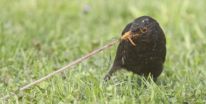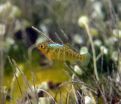(Press-News.org) This press release is available in German.
Animals have developed a variety of strategies for dealing with increasing noise pollution in their habitats. It is known, for example, that many urban birds sing at a high pitch to differentiate their song from the low-frequency sound of road traffic. However, as scientists from the Max Planck Institute for Ornithology discovered, this is just a useful side effect. The real reason for this behaviour is that songs at a higher pitch are also automatically louder. The birds can make themselves heard far better in city noise by increasing the volume of their song than by raising its frequency.
Despite the numerous unfavourable environmental conditions they encounter there, many wild animals have colonised cities as a new habitat. In cities they must deal with greater numbers of humans and with more light and noise pollution than they encounter in rural settings. However, the urban habitat also offers certain advantages, for example a more abundant supply of food and new breeding options. Many animals have thus adapted surprisingly well to city life.
To attract mating partners and defend their territories, urban robins sing in the latter night when the traffic noise decreases after the evening rush. Many other bird species, including blackbirds, sing in urban environments at a higher pitch. So their song is easier to detect in the lower-frequency traffic noise.
However, as a group of scientists from the Max Planck Institute for Ornithology in Seewiesen and Radolfzell has discovered, this is just half the truth. They studied urban blackbirds in the city of Vienna and country blackbirds in the nearby Vienna Woods. Additionally, they raised birds by hand at the Max Planck Institute and investigated the correlations between the frequency and amplitude of their song under controlled conditions. It emerged from this research that the animals were able to produce higher tones at higher amplitudes. In the city, blackbirds sing preferably at these high frequencies that they can produce particularly loudly.
In a further step, the researchers examined which effect is better suited to avoiding the acoustic masking by traffic noise: the higher frequency or the higher amplitude that results from it. "The higher volume of the higher-pitched song is more effective than the higher frequency," says Erwin Nemeth, first author of the study. "So we assume that the increased volume is the main cause of the higher frequency singing by city birds." Henrik Brumm, the leader of the research team, adds: "By actively selecting high-frequency sounds, the city birds can increase their capacity to sing loudly and in this way counteract the acoustic masking of their song by the ambient noise."
INFORMATION:
Original publication:
Erwin Nemeth, Nadia Pieretti, Sue Anne Zollinger, Nicole Geberzahn, Jesko Partecke, Ana Catarina Miranda and Henrik Brumm.
Bird song and anthropogenic noise: Vocal constraints may explain why birds sing higher frequency songs in cities.
Proceedings of the Royal Society B. Published online January 8, 2013 doi: 10.1098/rspb.2012.2798.
Clamorous city blackbirds
Birds can sing louder at higher frequencies and thereby make themselves heard in traffic noise
2013-01-11
ELSE PRESS RELEASES FROM THIS DATE:
Lady beetle diet influences its effectiveness as biocontrol agent
2013-01-11
This press release is available in Spanish.
By examining what lady beetles eat, U.S. Department of Agriculture (USDA) scientists are learning more about the movement of these beneficial insects in farm fields—and whether they'll actively feed on crop pests.
Agricultural Research Service (ARS) entomologist Jonathan Lundgren at the North Central Agricultural Research Laboratory in Brookings, S.D., and former ARS entomologist Michael Seagraves were part of a team of ARS and university scientists that examined how a lady beetle's diet alters its feeding patterns and ...
Nearby dwarf galaxy and possible protogalaxy discovered
2013-01-11
Peering deep into the dim edges of a distorted pinwheel galaxy in the constellation Ursa Major (the Great Bear), astronomers at Case Western Reserve University and their colleagues have discovered a faint dwarf galaxy and another possible young dwarf caught before it had a chance to form any stars.
Within the faint trails of intergalactic traffic, the researchers also found more evidence pointing to two already known dwarf galaxies as probable forces that pulled the pinwheel-shaped disk galaxy known as M101 out of shape.
M101 is the dominant member in a group of 15 ...
Game-based economics research explains why we roll the dice on flu shots
2013-01-11
With 41 states having reported widespread and severe outbreaks of flu this season, timely new research sheds light on why less than half of the American population has gotten a flu shot.
Despite widespread knowledge that a vaccine is the best way to reduce the chances of catching and spreading the flu, even three of the four main TODAY show anchors recently admitted they had not gotten a flu shot (until they did so live on the air).
Using an online computer game that simulates the spread of an infectious disease among its players, researchers at Wake Forest University ...
Experts aim to redefine healthcare and research ethics
2013-01-11
In what they acknowledge as a seismic shift in the ethical foundation of medical research, practice and policy, a prominent group of interdisciplinary healthcare experts, led by bioethicists at Johns Hopkins, rejects an ethical paradigm that has guided the American system since the 1970s and calls for morally obligatory participation in a "learning healthcare system" more in step with the digital age. The group has authored a pair of articles outlining their arguments and proposal for a new ethical framework, which appear in a special report from The Hastings Center Report, ...
Epigenomic abnormalities predict patient survival in non-Hodgkins lymphoma
2013-01-11
Think of the epigenome like a giant musical mixing board, turning up or down the expression of various genes. A University of Colorado Cancer Center study published today in the journal PLOS Genetics shows that in cancer, not only can genes themselves go bad, but abnormal changes in the epigenetic mixing board can unfortunately change the expression of these genes. Researchers hope to play the role of sound engineers, controlling these harmful epigenomic changes to turn down cancer itself or perhaps sensitize cancers to existing drugs.
The epigenome's primary tool – ...
A saliva gland test for Parkinson's disease?
2013-01-11
SAN DIEGO – New research suggests that testing a portion of a person's saliva gland may be a way to diagnose Parkinson's disease. The study was released today and will be presented at the American Academy of Neurology's 65th Annual Meeting in San Diego, March 16 to 23, 2013.
"There is currently no diagnostic test for Parkinson's disease," said study author Charles Adler, MD, PhD, with the Mayo Clinic Arizona and a Fellow of the American Academy of Neurology. "We have previously shown in autopsies of Parkinson's patients that the abnormal proteins associated with Parkinson's ...
Drug fails to help kidney transplant recipients
2013-01-11
Highlight
While safe and well-tolerated, angiotensin II blockade did not lessen tissue scarring or prevent kidney failure in kidney transplant recipients.
Angiotensin II blockade is known to slow kidney disease progression in individuals without transplants.
Washington, DC (January 10, 2013) — A drug that protects the kidneys of patients with chronic kidney disease does not seem to provide the same benefit to kidney transplant recipients, according to a study appearing in an upcoming issue of the Journal of the American Society of Nephrology (JASN).
Immunosuppressants ...
Kidneys sometimes removed unnecessarily due to misdiagnosis of genetic disorder
2013-01-11
Thousands of individuals have had kidneys removed unnecessarily because doctors misdiagnosed their disease.
A new, international study published in The Lancet indicates that approximately one of every five individuals with kidney tumors common in patients with tuberous sclerosis complex (TSC), a genetic disorder, has had a kidney removed. Moreover, 40 percent had some kind of surgical procedure performed.
Proper diagnosis could have led to treatment that would have made surgery or kidney removal unnecessary, according to John Bissler, MD, a nephrologist at Cincinnati ...
A snapshot of pupfish evolution in action
2013-01-11
Chris Martin has bred more than 3,000 hybrid fish in his time as a graduate student in evolution and ecology at UC Davis, a pursuit that has helped him create one of the most comprehensive snapshots of natural selection in the wild and demonstrated a key prediction in evolutionary biology.
"We can see a surprisingly complex snapshot of natural selection driving the evolution of new specialized species," said Martin, who with Professor Peter Wainwright published a paper on the topic in the Jan. 11, 2013, issue of the journal Science.
The "adaptive landscape" is very ...
PLOS Pathogens additional press release -- Jan. 10, 2013
2013-01-11
January 10, 2013
Scientists engineer the Schmallenberg virus genome to understand how to reduce disease caused by the virus.
Researchers from the MRC Centre for Virus Research at the University of Glasgow in Scotland have developed methods to synthesize and change the genome of Schmallenberg virus (SBV). SBV is a recently discovered pathogen of livestock such as cattle, sheep and goats. The researchers have laid bare important ways by which this virus causes disease. The full report about the study publishes on January 10 in the Open Access journal, PLOS Pathogens.
SBV ...
LAST 30 PRESS RELEASES:
Sleeping in on weekends may help boost teens’ mental health
Study: Teens use cellphones for an hour a day at school
After more than two years of war, Palestinian children are hungry, denied education and “like the living dead”
The untold story of life with Prader-Willi syndrome - according to the siblings who live it
How the parasite that ‘gave up sex’ found more hosts – and why its victory won’t last
When is it time to jump? The boiling frog problem of AI use in physics education
Twitter data reveals partisan divide in understanding why pollen season's getting worse
AI is quick but risky for updating old software
Revolutionizing biosecurity: new multi-omics framework to transform invasive species management
From ancient herb to modern medicine: new review unveils the multi-targeted healing potential of Borago officinalis
Building a global scientific community: Biological Diversity Journal announces dual recruitment of Editorial Board and Youth Editorial Board members
Microbes that break down antibiotics help protect ecosystems under drug pollution
Smart biochar that remembers pollutants offers a new way to clean water and recycle biomass
Rice genes matter more than domestication in shaping plant microbiomes
Ticking time bomb: Some farmers report as many as 70 tick encounters over a 6-month period
Turning garden and crop waste into plastics
Scientists discover ‘platypus galaxies’ in the early universe
Seeing thyroid cancer in a new light: when AI meets label-free imaging in the operating room
Neutrophil-to-lymphocyte ratio may aid risk stratification in depressive disorder
2026 Seismological Society of America Annual Meeting
AI-powered ECG analysis offers promising path for early detection of chronic obstructive pulmonary disease, says Mount Sinai researchers
GIMM uncovers flaws in lab-grown heart cells and paves the way for improved treatments
Cracking the evolutionary code of sleep
Medications could help the aging brain cope with surgery, memory impairment
Back pain linked to worse sleep years later in men over 65, according to study
CDC urges ‘shared decision-making’ on some childhood vaccines; many unclear about what that means
New research finds that an ‘equal treatment’ approach to economic opportunity advertising can backfire
Researchers create shape-shifting, self-navigating microparticles
Science army mobilizes to map US soil microbiome
Researchers develop new tools to turn grain crops into biosensors
[Press-News.org] Clamorous city blackbirdsBirds can sing louder at higher frequencies and thereby make themselves heard in traffic noise

